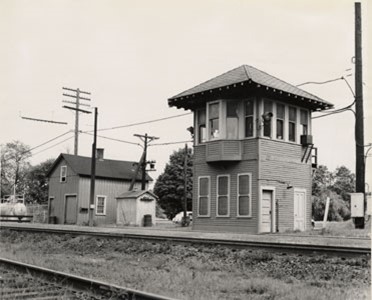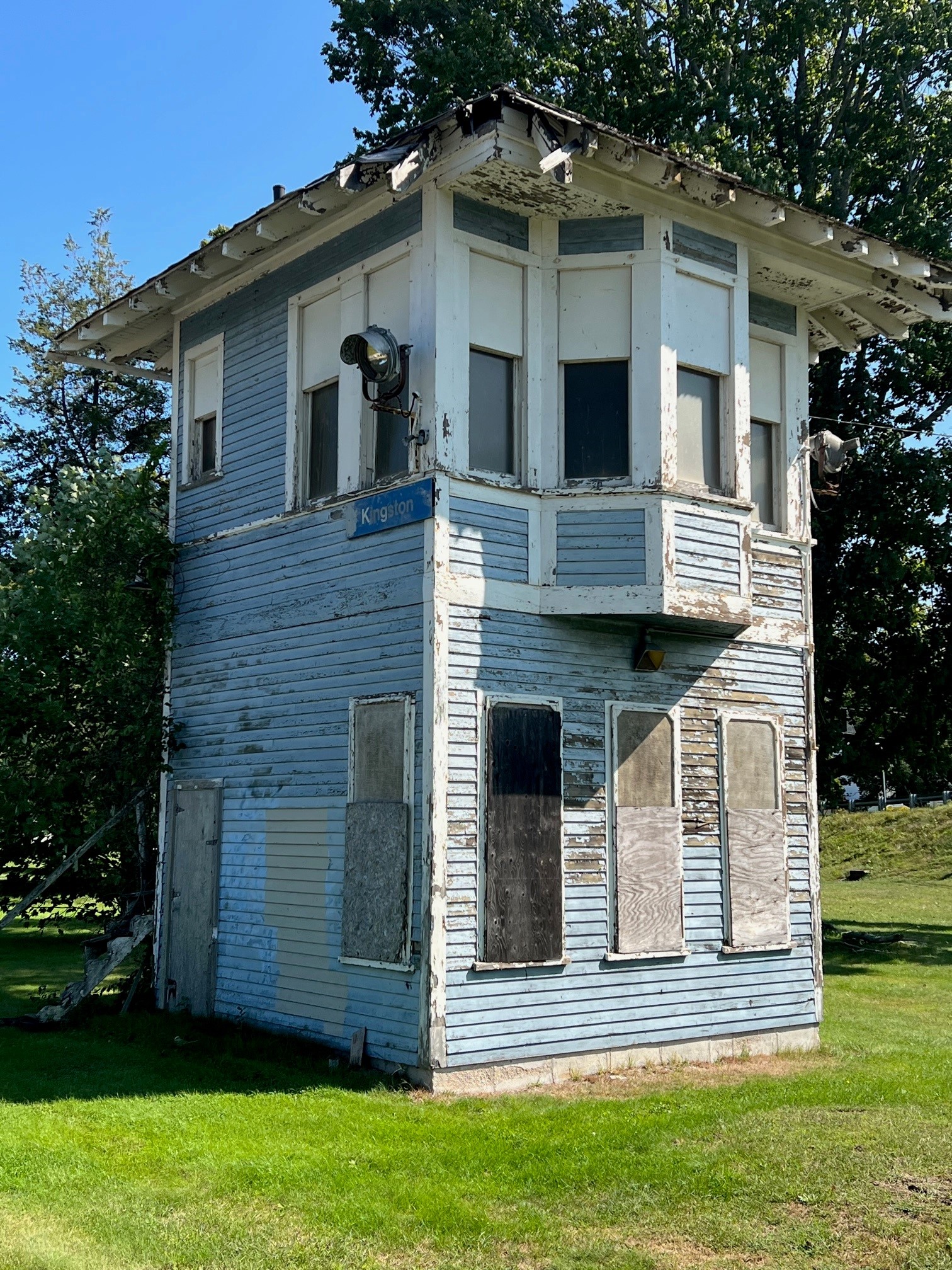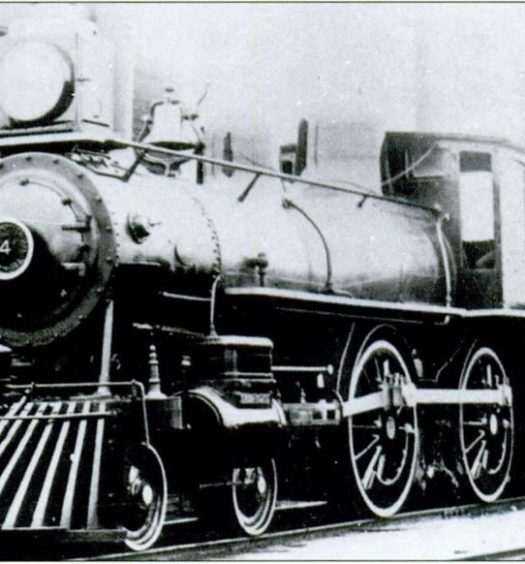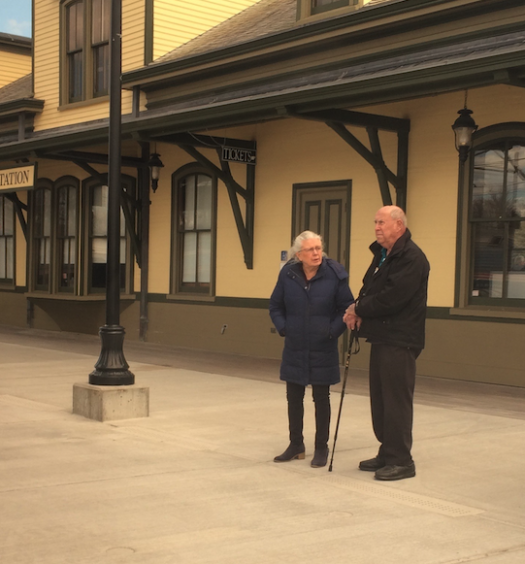In the hamlet of Kingston, stands—barely—a twentieth century railroad signal tower, outdated, outmoded, and tumbledown, composting in place, partially hidden by the Route 138 bridge, and mostly unnoticed by those passing over the bridge.
The signal tower is two stories high. Its roof shingles are either raised up off the roof boards or gone altogether. The tower is painted light blue with white trim on the door and window frames. The paint is either smudged, cracked, or peeled off. First-story window frames are boarded up; second-story frames are not. The outside stairway leading to the top-story door is still attached to the tower but is missing the bottom treads. The bottom-story door is pad locked. The bottom of the tower rests on a cement slab.
Interestingly, attached to two different outside boards on the second story are the cases for two spotlights (the spotlights are missing). Just below one of the cases is a sign identifying the tower’s location as Kingston. An unconnected electrical connection is also attached to a board just under the roof, and an electrical conduit runs from the connection down the side of the tower to an electrical meter and then to the ground. The spotlight cases, the sign, and the former electrical connection remind one of the signal tower’s original purpose in railroad history.
In general, signal towers, such as this one in Kingston, were part of an “interlocking system” that ensured safe train movements through the locale, especially if it was a railroad junction. Interlocking systems allowed a human operator to set manually track switches and corresponding signals to prevent trains from running onto the same track at the same time, thus averting a crash, a derailment, either human injury or death, as well as costly repairs to train cars and tracks. Signal towers are significant to railroading.
Signal towers traditionally stand at least two stores high. Operators on the second story moved levers connected to the first-story interlocking machine. That complex machine activated long metal rods connected to switches and signals around the signal tower’s vicinity. The operators set safe track routes and signals instructing train conductors and engineers to proceed at the prescribed speed, slow down, stop, or follow a different track.
The Kingston signal tower was built during the summer or early fall of 1930. A one-paragraph article in an August 1930 edition of the Narragansett Times notes that a new signal tower was being built at Kingston Station. This newly built signal tower was assigned the number 133+, according to the records of the New York, New Haven, and Hartford Railroad archived at the University of Connecticut.
It is pictured below when it functioned as a guide to trains passing through Kingston and is the one composting in place today. Note how close the tower is to the track.
As the twentieth century progressed from 1930 to 2000, railroad technology advanced. First, the levers and their attached machinery was replaced by an electric board featuring buttons that human operators pushed to set signals and switches. Late in the century, computers allowed the dispatching of trains and signal controls to become centralized in one place, such as at a major junction, in a large city (for example Providence), and not localized in a specific section of track, for example at Kingston.
Thus, local signal towers became antiquated, redundant, and superfluous. Several were simply pulled down, and the ground they once occupied often remained empty. A limited number were repurposed and refurbished either to fit the needs of other businesses unrelated to railroading or to become railroad and signal tower museums.
A final few were left standing, just as they were the day their doors were locked, and left to weaken, deteriorate, and (eventually) collapse. The doors to Signal Tower 133+ were locked in 1987, according to Frank Heppner, author of Railroads of Rhode Island: Shaping the Ocean State’s Railways.
Enter the Friends of the Kingston Railroad Station. By 1972, Kingston Station had become dilapidated. In 1973, the Friends of the Kingston Railroad Station, a volunteer group of railfans, formed to restore the station. In 1974, 180 members of the community volunteered to repaint the station. In 1975, the Friends placed the station on the National Register of Historical Buildings. The Penn Central Railroad, owner and operator of the station, permitted the improvements and donated $10,000 to buy paint and to rent equipment.
The restoration project was completed; the community celebrated. Then Amtrak took over passenger service at the train station, and the Rhode Island Department of Transportation took over ownership of the buildings at the station.
Thirteen years later, in 1988, a year after the signal tower was closed, a fire almost forced the closure of Kingston Station. Jack McCabe, the station agent at the time, sold tickets out of the west, relatively undamaged, side of the station. Trains still stopped at the station to pick up and drop off passengers.
Amtrak planned to tear down the station and eliminate the Kingston stop. Amtrak was under much pressure at the time to cut costs and removing the Kington facility would have eliminated three positions, according to McCabe. McCabe’s immediate supervisor even suggested passengers living in Narragansett, North Kingstown, and South Kingstown could drive to Providence or Westerly to board a train.
Panic set in not only among rail passengers but also railfans. However, McCabe, the station agent who was also an original member of the Friends of the Kingston Station, discovered the paperwork for the National Register of Historical Places that included the stipulation that an owner of a structure placed on the National Register of Historic Buildings could not tear it down. The Kingston Station had been placed on the Register in 1975, thanks to the Friends.
Thus, the Friends revived itself and began what seemed like 10,000 hours of mind-numbing work dealing with various government agencies at the state and national level as well as with Amtrak itself. Two million dollars was raised to restore the station. The efforts were successful, stunningly so. Passenger service resumed and even improved. Ridership increased over the years.
Other structural enhancements were called for and were added in and around the station building. By 2023, some $30 million has been invested in the Kingston Station area to construct a rail-passenger overpass, high-level passenger platforms, a high-speed passing track for the Acela, additional sidings, and improved landscaping. The improvements worked. In 2019, the year before the pandemic, there were 175,000 passengers either boarding or getting off at Kingston Station, which ranked it around 50th out of 400 Amtrak stations nationally.

The Kingston Station Signal Tower in September 2022; note the dilapidated staircase (Christian McBurney)
Since the Friends were railfans and had invested much sweat equity in the Kingston Station, the volunteer group decided to open and operate a small railroad museum in the west waiting room of the station. Heppner curated the museum, monitoring and maintaining the displays and making sure donors received thank-you letters. The museum became one of Rhode Island’s most popular museums, according to Heppner.
However, after several years of educating the public about railroads in general and Rhode Island railroads in specific, the museum was forced to close. A person of influence in one of the bureaucracies determining policy for the station insisted a second waiting room at the station was more important than the museum, even if the second waiting room is rarely used today by passengers.
The displays the Friends had gathered were packed up and stored, the funds donated to the Friends were donated to other worthy causes, the membership dwindled to the non-support level, and the handful of remaining survivors disbanded the Friends.
The disbanded Friends suddenly and unexpectedly revived for the third time in 2022. A committee had been created to celebrate the 300th Anniversary of the Town of South Kingstown. Three members of that committee had a particular interest in the signal tower, by now closed for thirty-seven years, still composting in place, guttered of its interlocking machinery, and moved away from the track to where it now rests, partially hidden by the Route 138 overpass.
In March of 2022, this new edition of the Friends gathered on a chilly, sunny morning with an administrator of the Rhode Island Department of Transportation to open the bottom-story door of the tower and assess the condition of the interior. The administrator brought a key to what the administrator said fit the lock on the door. The key did not fit the lock.
An enterprising member of the Friends surprisingly found a crowbar and broke open the door causing it to sag not surprisingly on its hinges. Inside the Friends found the wooden floor of the second story collapsed onto the first floor, the splintered wood looking like the children’s game of pick-up-sticks. Sun light leaked in through the cracked wall boards. Yet lying in the rubble and leaning against the wall was the model board that once upon a time monitored train traffic along the line.
After all the Friends present had viewed the inside, the door was finally nailed shut. But immediately after, plans to restore the dilapidated tower were suggested by those walking around it, their shoes wet in the glistening, dewy grass.
The brain-storming plans included moving the signal tower to the grassy oval in front of the Kingston Station, restoring the second story and outfitting it as a museum to itself and to South Kingstown railroads, and restoring the first story and outfitting it as a small coffee shop with bathrooms and a welcome center to the South County towns for the convenience of rail passengers entering and leaving the station.
Over the next two years little has been done. The Rhode Island Department of Transportation erected a fence that now surrounds it. The Town of South Kingstown supported an arrangement wherein the Town would lease the land on which the tower stands from the State of Rhode Island and sublet the land to the Friends of The Kingston Station for a nominal fee, according to Murray Gates, the Friends president. That agreement has not yet started.
Twice before the Friends found the funds, the skills, and the volunteers to twice restore Kingston Station. It appears that for a third time, the Friends need to find the funds, the skills, and the volunteers to restore a rundown railroad relic into a preserved railroad artifact.
Another member of the Friends, retired state Supreme Court judge Gilbert Indeglia, believes that restoration of the signal tower would complement the restoration of several buildings already completed on the Route 138 corridor running through West Kingston. Several locals once had family who worked at the signal tower, and, historically, the tower is the last building that was part of the campus with the station.
(For more on Kingston Station, see “Saving and Restoring Kingston Station, and a Railfan’s Life, Parts I and II, by Frank Heppner, at the Online Review of Rhode Island History at https://smallstatebighistory.com/saving-and-restoring-kingston-station-and-a-railfans-life-part-i/ and at https://smallstatebighistory.com/saving-and-restoring-kingston-station-and-a-railfans-life-part-ii/).



























